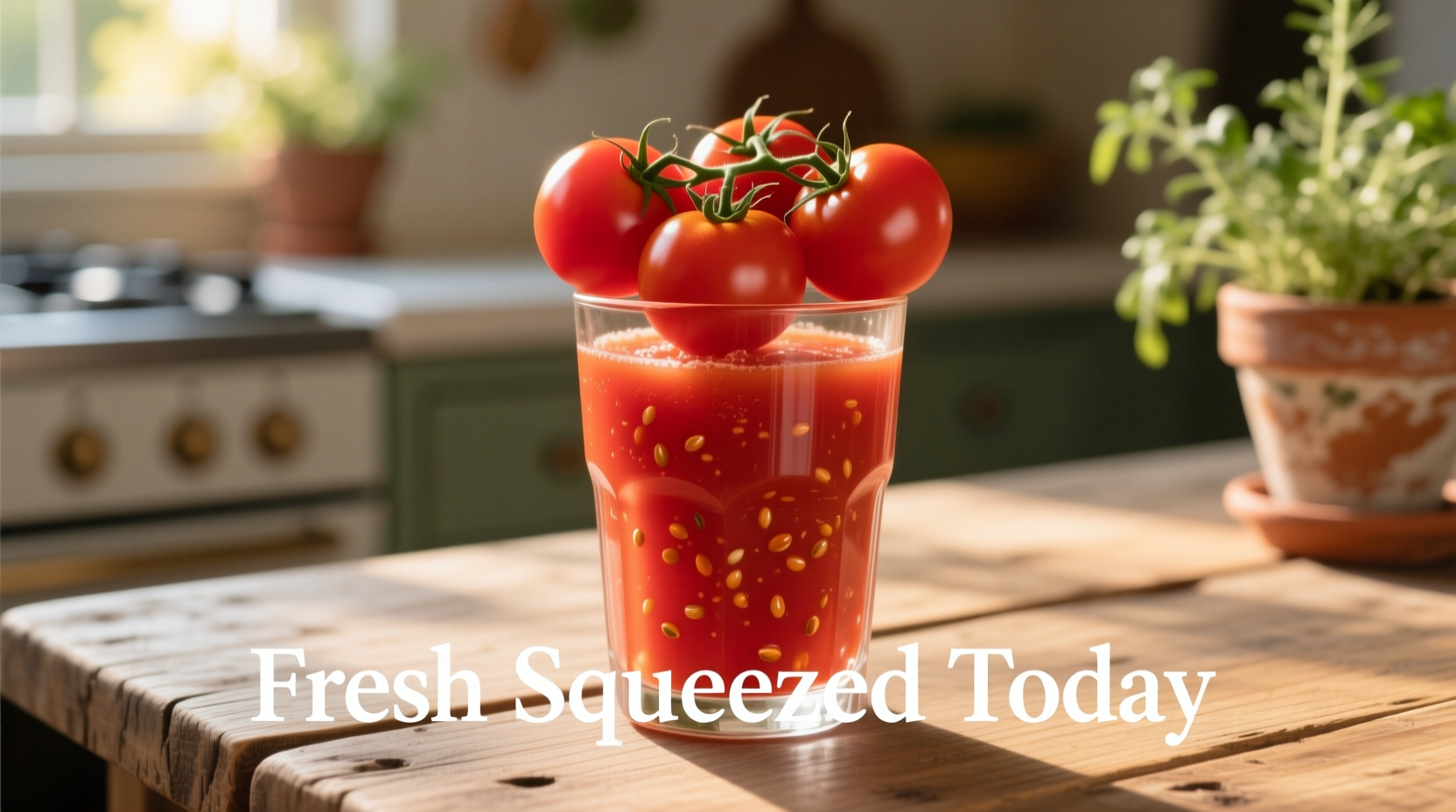Tomato juice isn't just a brunch staple—it's a nutritional powerhouse backed by decades of research. As someone who's studied food chemistry and sensory properties across global cuisines, I've seen how this vibrant red beverage delivers measurable health advantages when chosen wisely. Let's explore exactly how tomato juice affects your body, how it compares to other options, and how to maximize its benefits.
What Makes Tomato Juice Nutritionally Unique
Unlike many fruit juices, tomato juice offers a distinctive nutritional profile that aligns with dietary recommendations from major health organizations. The USDA FoodData Central reveals that an 8-ounce (240ml) serving of unsalted tomato juice contains:
| Nutrient | Amount per 8oz | % Daily Value | Key Health Benefit |
|---|---|---|---|
| Lycopene | 22-28mg | N/A | Powerful antioxidant linked to reduced heart disease risk |
| Vitamin C | 124mg | 138% | Immune support and collagen production |
| Potassium | 527mg | 15% | Blood pressure regulation |
| Vitamin K | 27mcg | 23% | Bone health and blood clotting |
| Natural Sugars | 8g | N/A | Significantly less than most fruit juices |
This nutritional composition explains why researchers at the American Heart Association recognize tomato products as part of heart-healthy dietary patterns. The lycopene content particularly stands out—processing tomatoes into juice actually increases lycopene bioavailability compared to raw tomatoes.
Science-Backed Health Benefits of Daily Tomato Juice
Heart Health Protection
A 2022 meta-analysis published in Nutrients reviewed 15 clinical trials involving over 500 participants. Researchers found that regular tomato juice consumption (8-12 ounces daily for 8-12 weeks) significantly reduced:
- LDL cholesterol by 8-10%
- Systolic blood pressure by 4-6 mmHg
- Markers of inflammation like C-reactive protein
The Mayo Clinic notes that the potassium and lycopene combination works synergistically to support cardiovascular function—making tomato juice particularly beneficial for those with hypertension.
Cancer Risk Reduction Potential
Lycopene's antioxidant properties have been extensively studied for cancer prevention. According to the National Cancer Institute, population studies show men who consume tomato products regularly have a 15-20% lower risk of prostate cancer. While not a treatment, the consistent association in research suggests tomato juice contributes to a cancer-preventive diet.

Skin Health and Anti-Aging Effects
Research from Osaka University demonstrated that women who consumed 16 ounces of tomato juice daily for 12 weeks showed measurable improvements in skin hydration and elasticity. The vitamin C content supports collagen production while lycopene provides photoprotection against UV damage—making tomato juice benefits for skin increasingly recognized by dermatologists.
Important Considerations and Limitations
Sodium Content: The Critical Factor
Most commercial tomato juices contain 600-800mg of sodium per 8-ounce serving—nearly one-third of the American Heart Association's recommended daily limit. This transforms a potentially healthy beverage into a concern for those with hypertension. Always choose "no salt added" varieties and check labels for sodium content below 140mg per serving.
Who Should Moderate Intake
While generally safe, certain individuals should monitor their consumption:
- Kidney stone formers: Tomato juice contains moderate oxalates (10-15mg per serving)
- GERD sufferers: Acidity may trigger symptoms in sensitive individuals
- Those on blood thinners: Vitamin K content requires consistent intake
The National Institute of Diabetes and Digestive and Kidney Diseases recommends discussing tomato juice consumption with your healthcare provider if you have these conditions.
Tomato Juice vs. Alternatives: Making the Right Choice
Understanding how tomato juice compares to other options helps you make informed decisions:
| Beverage | Sugar (per 8oz) | Lycopene | Best For |
|---|---|---|---|
| Tomato Juice (unsalted) | 8g | High | Heart health, low sugar needs |
| Fresh Tomatoes (equivalent) | 5g | Medium | Fiber intake, lower calorie |
| Orange Juice | 21g | None | Vitamin C boost |
| Vegetable Juice Blend | 5g | Medium | Variety of nutrients |
Research shows that the lycopene in tomato juice has 2-3 times higher bioavailability than in raw tomatoes due to the heating process during production. However, fresh tomatoes provide more fiber. For maximum benefit, consider alternating between both forms.
Practical Recommendations for Optimal Benefits
Based on current nutritional science, here's how to incorporate tomato juice effectively:
Daily Intake Guidelines
- Standard recommendation: 4-8 ounces daily for most adults
- Heart health focus: 8 ounces of low-sodium variety daily
- Weight management: 4 ounces as part of a balanced meal
Maximizing Nutrient Absorption
Lycopene is fat-soluble, meaning absorption increases significantly when consumed with healthy fats. Try these simple combinations:
- Add 1 teaspoon of extra virgin olive oil to your glass
- Enjoy with avocado toast or nuts
- Include in smoothies with chia seeds or flax
Choosing the Best Product
When selecting store-bought tomato juice, look for:
- "No salt added" or "low sodium" labeling
- Minimal ingredients (tomatoes, maybe citric acid)
- Carton or glass packaging (BPA-free)
- Avoid varieties with added sugar or artificial flavors
Homemade tomato juice allows complete control over ingredients. Simply blend ripe tomatoes, strain if desired, and consume within 3 days for maximum nutrient retention.











 浙公网安备
33010002000092号
浙公网安备
33010002000092号 浙B2-20120091-4
浙B2-20120091-4